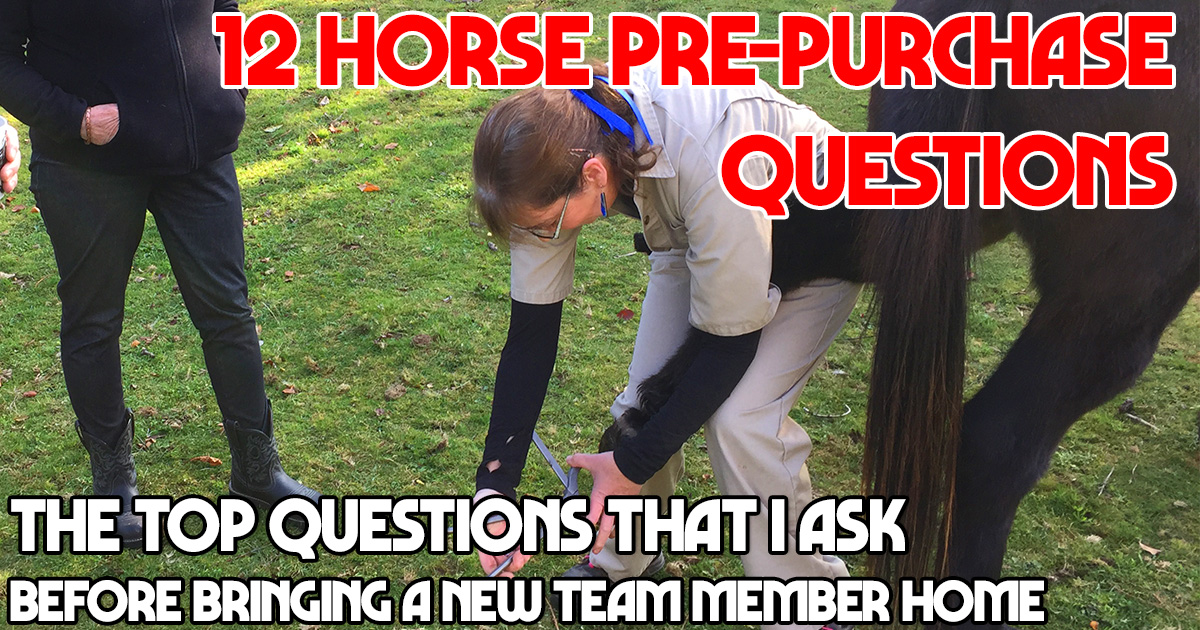12 Horse Pre-Purchase Questions – What I look for in a Trail Horse or Mule
As published in Western Mule Magazine March 2020 edition.
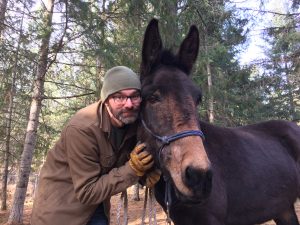 I’ve said for years, to many thousands of people around the nation, that I thought the perfect trail mount would be an Icelandic Mule. Well, I finally found one while leading trail riding clinics in Canada. Meet Cocoa. Cocoa is a 13.1 hand molly mule out of an Icelandic mare. She’s 14 years old and as green as the grass in Washington where she’s lived for the past 8 years with Nancy and her job was to be cute and eat apples. Cocoa is VERY good at being cute and eating apples. However there’s a lot more to helping a mule find the great trail mount within than being cute and eating apples. They need to pass numerous disposition and health checks before they can come home. Here’s what I think we should look for before you buy.
I’ve said for years, to many thousands of people around the nation, that I thought the perfect trail mount would be an Icelandic Mule. Well, I finally found one while leading trail riding clinics in Canada. Meet Cocoa. Cocoa is a 13.1 hand molly mule out of an Icelandic mare. She’s 14 years old and as green as the grass in Washington where she’s lived for the past 8 years with Nancy and her job was to be cute and eat apples. Cocoa is VERY good at being cute and eating apples. However there’s a lot more to helping a mule find the great trail mount within than being cute and eating apples. They need to pass numerous disposition and health checks before they can come home. Here’s what I think we should look for before you buy.
Before meeting Cocoa, furry face to furry face I had a lot of horse pre-purchase questions for Nancy. I think every potential buyer needs to ask these initial questions, at a minimum, of every seller of an animal.
- What’s her disposition like?
- I’m not a fan of drama so words like “kind, curious, sweet, and easy going” are important to me.
- What does she do or has been asked to do?
- Had I not been looking for an opportunity to train I would have passed on an animal whose sole career has consisted of “being cute and eating apples”. For most trail riders I would ask about what experiences, and training, the animal has had.
- How does she interact with other members of the herd?
- Cocoa’s position at the bottom of the herd pecking order was to me a good thing as I believe that such animals are already habituated to following a leader. They’re content to stay in the background and avoid any heated encounters. I just need to be a good and benign leader for her.
- How does she interact with people?
- Hearing “pocket pony” made a lot of sense especially given her job of being cute. However, having an 800lb animal in your space begging for apples may not be a good thing. I like critters to respect my personal space unless I ask them to approach, not before.
- What’s her medical history look like?
- Ask about vaccination history, deworming information, recent Coggins testing, dental exams, last teeth floating and any medical issues. Nancy was very forthcoming about a stifle issue, and that other than Cocoa was due for a pedicure and vaccinations, there were no issues.
Once these initial horse pre-purchase questions were satisfactorily answered it was time for an in person interview and even more horse pre-purchase questions.
Disposition
The most important trait that I’m looking for is a good disposition. An animal with a kind and willing disposition is much easier to work with and train for the challenges that it will be asked to face. Unless you like drama on your rides, look for an animal that is neither over reactive nor has an overly high flight instinct. A calm, curious, and willing disposition will help a good trail mount to stand quietly while tied, remain calm on the edge of a mountain, and get along with other horses in camp (as well as cows, dogs, elk, and deer).
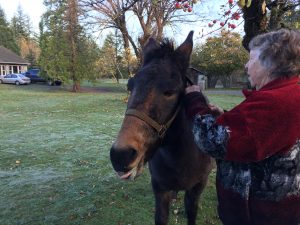 Cocoa’s curious, friendly disposition won me over immediately. Yes, I’m a sucker for a kind eye! Beyond the kind eye was a willingness to let a stranger pick up her feet, allow me to touch her all over her body, and be led away from her herd and friends. All that being said, I’m not an expert and rely on people with a far greater level of experience than I. Thankfully I have Ed Haefliger, a noted mule expert on the west coast. My first phone call after meeting Cocoa was to Ed asking if he and Sue would look at Cocoa with me the following week. Having someone more knowledgeable and objective than you is a valuable resource to take advantage of.
Cocoa’s curious, friendly disposition won me over immediately. Yes, I’m a sucker for a kind eye! Beyond the kind eye was a willingness to let a stranger pick up her feet, allow me to touch her all over her body, and be led away from her herd and friends. All that being said, I’m not an expert and rely on people with a far greater level of experience than I. Thankfully I have Ed Haefliger, a noted mule expert on the west coast. My first phone call after meeting Cocoa was to Ed asking if he and Sue would look at Cocoa with me the following week. Having someone more knowledgeable and objective than you is a valuable resource to take advantage of.
Beyond the “kind eye” other observations that I noted during our first in person meetings included:
- Observing her motion while being led. Is her walk sure-footed and even?
- Cocoa walked forward without any indication of stiffness or lameness.
- Ask to see the horse groomed to observe its habits when handled.
- Cocoa stood like a statue and allowed me to pick up, and manipulate each hoof, as well as rub her all about her body and ears.
- Check for basic conformation and look for signs of blemishes or uneven wear of the feet and shoes.
- Other than being a bit cow-hocked Cocoa seemed to be in fine shape other than a bit portly. An inspection of her feet showed that she was due for a trim but little else of concern.
- Observe its action as it is led to and away from you, both at a walk and a jog.
- I should have asked Nancy to lead her but instead I walked Cocoa and did my best to verify that her gait was easy, equal, and in line.
Upon their meeting with Cocoa both Ed and Sue recommended that I take her home. Sue was impressed with Cocoa’s curiosity and friendliness to strangers. I do believe that had I passed on her, Sue would have taken Cocoa home that day!
Conformation and Health
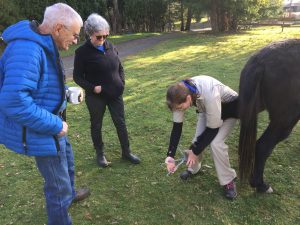 Of course disposition isn’t the only consideration. A TrailMeister team member needs to do a lot more than be cute and eat apples! We work hard during the summer months and everyone on the team has to be able to keep up. For Cocoa this means that she’ll need to be able to pack and ride for long days in the high mountains. Again, this is an area where I look to the experts. So even though I was excited, and wanted to load the trailer before Nancy changed her mind, I called on Doc Smith of the Kulshan Veterinary Hospital in Bellingham, WA. for a comprehensive pre-purchase examination.
Of course disposition isn’t the only consideration. A TrailMeister team member needs to do a lot more than be cute and eat apples! We work hard during the summer months and everyone on the team has to be able to keep up. For Cocoa this means that she’ll need to be able to pack and ride for long days in the high mountains. Again, this is an area where I look to the experts. So even though I was excited, and wanted to load the trailer before Nancy changed her mind, I called on Doc Smith of the Kulshan Veterinary Hospital in Bellingham, WA. for a comprehensive pre-purchase examination.
The animal you’re considering may seem perfect but in order to make an informed decision and to help decide if you can live with its inevitable flaws an unbiased clinical evaluation from a medical professional is crucial.
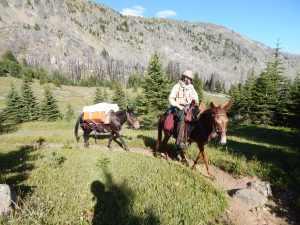
Cocoa will be working in areas like this, deep within the Pasayten Wilderness.
Before she started her evaluation Doc Smith made a point of asking me what Cocoa’s future job would be. Those questions weren’t for the sake of small talk. Doc Smith knows that no animal is perfect and if examined rigorously enough, faults can be found. Knowing what the animal’s job will be helps the veterinarian determine if she’ll be sound and serviceable for that job.
For this exam Doc Smith went through 18 different points that encompassed Cocoa’s overall body condition. These exams looked at every part of Cocoa from nose to tail. Most results were within a reasonable range but a few issues of concern were noted.
- Skin condition – It was noted that Cocoa tends to shed out later than the herd of horses that she lives with. Delayed shedding is a symptom of Cushings Disease. We’ll run diagnostic tests on her in the coming year.
- Hoof condition – Cocoa had thrush in all four feet. In the wet conditions of western Washington it’s fairly common. With good farrier care, regular exercise and proper hoof hygiene she should be as good as new.
- Luxating patella – In layman’s terms, she’s got a trick knee. Fortunately the condition can be mitigated through exercise.
Pre-purchase exams aren’t pass / fail tests. They are simply a data set that helps you as a buyer make the most informed decision. In this case I felt that I could live with her flaws. The next steps will be the hard ones as I take a green as grass mule and help her gain a foundation as an honest worker. Stay tuned!
For the most comprehensive guide to horse trails and camps in the world visit the trails section of TrailMeister https://www.trailmeister.com/trails/ and find your next favorite place!


